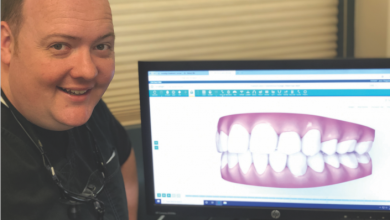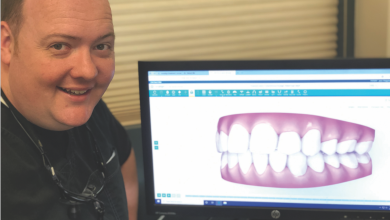Designing Your Smile
One of the most frequent questions asked in the dental office is, “How can I make my smile look better?” There are many reasons people want an inviting smile – to feel more confident, to not feel embarrassed, to improve their image when interviewing for a job, and to simply feel more comfortable laughing and talking with others.
Most people ask for their teeth to be whiter and straighter – the “Hollywood” smile. There are three basic ways to achieve a whiter and straighter smile. Veneers are the option people are generally familiar with. A veneer is simply a thin piece of porcelain that is overlaid onto the lip side surface of the tooth. Sometimes, only one veneer is placed to correct a dark or a misshapen tooth. Other times, ten or twelve will be placed to entirely re-design a person’s appearance. Veneers are a nice option because they can change shape as well as color and they are color stable into the future.
Our smile design process at Today’s Dentistry includes an in-depth discussion about the shape of a person’s teeth – do they want rounded corners? Or square corners? All the biting edges at the same or at different levels? Pointed canines or flattened canines? We use picture books to help illustrate the subtle differences between each of these choices. When a patient distills their vision down to a clear picture, we then communicate that with our laboratory. Based on the patient’s preferences, our lab creates a diagnostic wax-up. This is a wax representation on models of the patient’s teeth, demonstrating what the final outcome may look like.
For me, the diagnostic wax-up is one of the most important parts of the smile design process. Not only does it allow for better planning and preparation, it also can be used to make temporary veneers for the patient so that s/he can “test drive” their new smile. For example, a patient may have asked for square corners and find that they prefer rounded corners. This information can then be relayed to the lab before creating the final veneers, resulting in a more pleasing outcome for the patient.
Another method of smile design is orthodontics, or braces. In dentistry, we are able to attach brackets and wires onto teeth and move them where we want them, essentially designing a person’s smile. Clear, rigid “aligners” can also be used to accomplish this tooth movement, although aligners do not allow the same level of control and precision that brackets and wires do. Orthodontics levels and aligns teeth, providing patients with straight teeth, well-rounded dental arches, and good “bites.”
A major advantage of orthodontics over veneers is that, with orthodontics the teeth are not prepared as they are with veneers. A tooth almost always is strongest and most resistant to wear in its natural form. When a tooth is cut – whether to remove a cavity and place a filling, or to make it ready for a veneer or a crown, it is compromised. And so, in many cases, orthodontics is a more conservative treatment option. However, orthodontics will not change the shade or shape of teeth like veneers can. If you have questions about what is best for you, ask your dentist. S/he will provide good advice.
There are times when simply whitening an individual’s teeth will accomplish the desired change in smile appearance. A person can whiten their teeth with over-the-counter (OTC) products, custom take home products, or in-office products. The differences are specificity and strength. An OTC product will have a generic fit. Therefore it will whiten most areas in an acceptable fashion; however, it may not have the specificity of fit that will allow for certain corners, or nooks and crannies in between the teeth, to get whitened. A custom made whitening appliance from a dental office will have a patient specific fit, unique to each patient. It will therefore perform better at whitening those difficult to reach corners and individual anatomies specific to someone’s mouth. Either of these two options requires diligence over a period of time to achieve the desired result.
In-office whitening options have great specificity and high strength. This is why they are used in the office, under direct supervision. The gum tissues are typically barricaded in some way from the whitening solutions, as they will damage the gum tissues. Retraction of lips and cheeks is also important for this reason. Sometimes special lights are used to “activate” the whitening product. Independent research has shown that results achieved with lights are typically short lived as they depend on dehydration of the teeth. When teeth rehydrate, a relapse to the original shade is often noted. Another drawback to in-office options is that a patient’s teeth are typically quite sensitive for several days afterward due to the high strength of the products used.
An important consideration in maintaining whitening results deals with diet. If a patient is ingesting food and drink associated with staining teeth, s/he may not be pleased with the recurring staining. Tea, coffee, colas, red wines, grape juice, tobacco products, and berries can all stain teeth and counteract any whitening efforts being made.
There is no “best way” for everyone to achieve the smile they want. If you are considering changing your smile, talk to your dentist. S/he will be able to discuss the available options with you and help you get what you are hoping for.
Yours in Dental Health,
Ed


